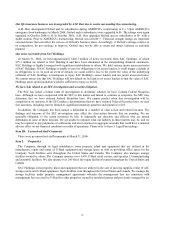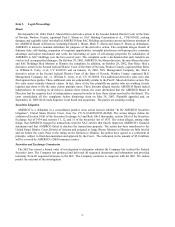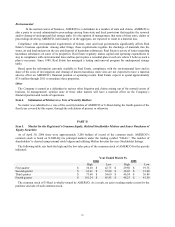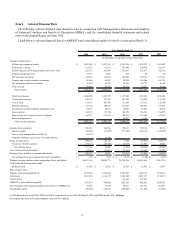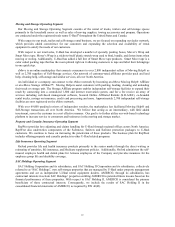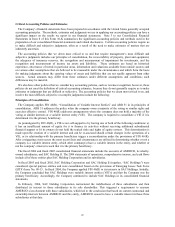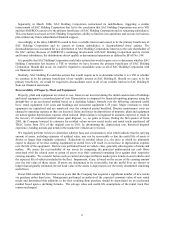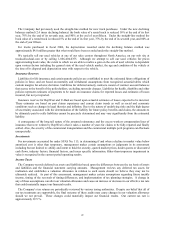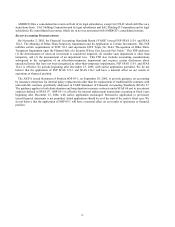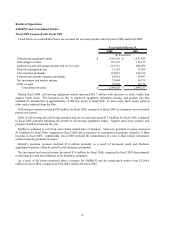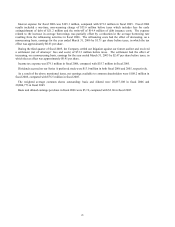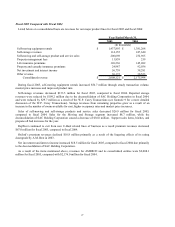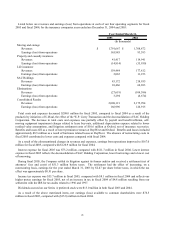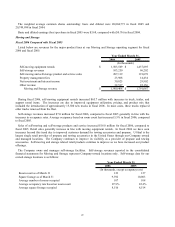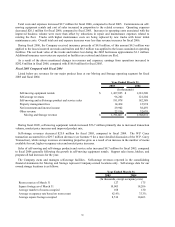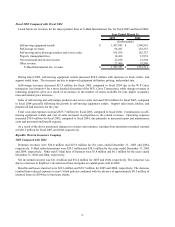U-Haul 2006 Annual Report Download - page 105
Download and view the complete annual report
Please find page 105 of the 2006 U-Haul annual report below. You can navigate through the pages in the report by either clicking on the pages listed below, or by using the keyword search tool below to find specific information within the annual report.The Company had previously used the straight-line method for new truck purchases. Under the new declining
balances method (2.4 times declining balance) the book value of a rental truck is reduced 16% at the end of its first
year, 70% by the end of its seventh year, and 80% at the end of year fifteen. Under the straight-line method the
book value of a rental truck is reduced 5% at the end of its first year, 37% by the end of its seventh year, and 80% at
the end of year fifteen.
For trucks purchased in fiscal 2006, the depreciation recorded under the declining balance method was
approximately $4.0 million greater that what would have been recorded under the straight-line method.
We typically sell our used vehicles at one of our sales centers throughout North America, on our web site at
trucksales.uhaul.com or by calling 1-866-404-0355. Although we attempt to sell our used vehicles for prices
approximating book value, the extent to which we are able to realize a gain on the sale of used vehicles is dependent
upon various factors including the general state of the used vehicle market, the age and condition of the vehicle at
the time of its disposal and depreciation rates with respect to the vehicle.
Insurance Reserves
Liabilities for life insurance and certain annuity policies are established to meet the estimated future obligations of
policies in force, and are based on mortality and withdrawal assumptions from recognized actuarial tables which
contain margins for adverse deviation. Liabilities for deferred annuity contracts consist of contract account balances
that accrue to the benefit of the policyholders, excluding surrender charges. Liabilities for health, disability and other
policies represent estimates of payments to be made on insurance claims for reported losses and estimates of losses
incurred, but not yet reported.
Insurance reserves for RepWest and U-Haul are based upon actuarial estimates of losses expected to be incurred.
These estimates are based on past claims experience and current claim trends as well as social and economic
conditions such as changes in legal theories and inflation. Due to the nature of underlying risks and the high degree
of uncertainty associated with the determination of the liability for future policy benefits and claims, the amounts to
be ultimately paid to settle liabilities cannot be precisely determined and may vary significantly from the estimated
liability.
A consequence of the long tail nature of the assumed reinsurance and the excess workers compensation lines of
insurance that were written by RepWest is that it takes a number of years for claims to be fully reported and finally
settled. Also, the severity of the commercial transportation and the commercial multiple peril programs can fluctuate
unexpectedly.
Investments
For investments accounted for under SFAS No. 115, in determining if and when a decline in market value below
amortized cost is other than temporary, management makes certain assumptions or judgments in its assessment
including but not limited to: ability and intent to hold the security, quoted market prices, dealer quotes or discounted
cash flows, industry factors, financial factors, and issuer specific information. Other-than-temporary impairment in
value is recognized in the current period operating results.
Income Taxes
The Company records deferred tax assets and liabilities based upon the differences between the tax basis of assets
and liabilities and the financial statement carrying amounts. Management reviews any deferred tax assets for
realization and establishes a valuation allowance in relation to such assets should we believe they may not be
ultimately realized. As part of this assessment, management makes certain assumptions regarding future taxable
income, timing of the reversals of timing differences, and implementation of tax planning strategies. A change in
any of these assumptions can alter our valuation allowance and cause an increase or decrease in our effective tax rate
that could materially impact our financial results.
The Company’ s tax returns are periodically reviewed by various taxing authorities. Despite our belief that all of
our tax treatments are supportable, the final outcome of these audits may cause changes in our valuation allowance
should we not prevail. These changes could materially impact our financial results. Our current tax rate is
approximately 39.5 %.
22


